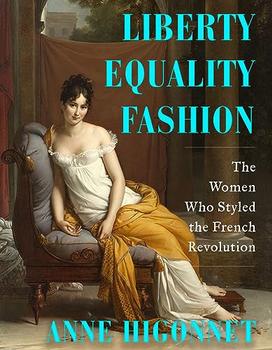Summary | Excerpt | Reviews | Beyond the Book | Readalikes | Genres & Themes | Author Bio

The Women Who Styled the French Revolution
by Anne Higonnet
The Tascher de La Pagerie family longed to escape their Creole status. They were very minor nobility, rendered yet more marginal within the French aristocracy by their residence in Martinique. The most ambitious and enterprising member of the family, Rose's father's sister Désirée de Renaudin, escaped the Antilles to live flagrantly for many years with a noble lover: François de Beauharnais, Marquis de la Ferté-Beauharnais. Though her lover was dearly attached to her, and would in fact marry her much later, when he was eighty-two and both their spouses had died, her situation before 1779 was irregular. To consolidate her place in the family, she announced that one of her Martinique brother's three daughters must marry her lover's heir. It didn't matter which niece. "We must have one of your children."
The middle Tascher de La Pagerie sister was first designated because at thirteen, she was considered the right age, but then she died of disease. Next selected was the youngest sister, but after thinking it over, Monsieur and Madame Tascher de La Pagerie felt eleven was too young. That left Rose, the eldest, who was then fifteen. If only, Rose's family must have thought as they plotted, the girl could have been born with a pink-and-white porcelain complexion, classical face, and soft smooth curves. She was not very pretty by the standards of the eighteenth century, with small sharp features, matte complexion, bad teeth, and fine dark hair. Regardless, she was adequate to the family's purpose.
The marriage terms were settled. Rose was shipped off to France with Euphémie to take care of her. She was married to the vicomte Alexandre de Beauharnais in December of 1779, and thus became Rose, Vicomtesse de Beauharnais. Rose's new in-laws agreed she was amenably docile, luckily, because she needed polish. She had not received much formal education, and what little she had learned from nuns on Martinique was provincial by Paris standards. Her husband hoped she could be improved. He wrote his father, "She may seem less pretty than you expected."
The Beauharnais family felt its own social insecurities. It did not rank much higher on the social scale than the Tascher de La Pagerie family. All too recently, members of the Beauharnais family had been in trade, or in law. Yet according to the minutely calibrated competition among French nobles, a mainland marquis was superior to a colonial seigneur. In 1786, Alexandre de Beauharnais petitioned to be presented at the royal court of Versailles, only to be devastatingly snubbed by an etiquette-enforcer, who passed on the verdict of a court genealogist: "M. de Beauharnais is not suitable for the Court Honors he solicits." One of the branches of his family had been convicted of being "usurpers" of their title—in 1667.
Madame de Renaudin, therefore, had an urgent shopping task in Paris. Rose must begin to appear noble—as noble as sumptuary law would allow. Madame de Renaudin was not going to take any chances. If she shopped carefully in the right Paris clothing boutiques, her niece could meet expectations. Madame de Renaudin had about 20,000 livres to spend on the bride's trousseau: the clothing and linens that equipped girls to become wives. Status signs played such a major role in any arranged marriage that this money was most of what the Tascher de La Pagerie family paid up front for their daughter's dowry; payment of the rest of the dowry was vaguely promised for the future. Compared with the 400,000 livres that the empress of Austria had paid for her daughter Marie Antoinette's royal trousseau, 20,000 livres was paltry. Compared with the 270 livres a skilled working woman could earn in a year, however, the sum was definitely aristocratic.
Foundations first. Aunt and niece gazed through their carriage windows, scanning the many wrought-iron signboards for the name of the little boutique on their list, and the image that indicated the stays tailor they were looking for. When their carriage stopped and they descended, they paused to look at a few specimens of the tailleur de corps craft though small leaded glass windows on either side of its narrow, carved wood door. They entered a dim space with nothing for sale to be seen, because nothing was ready-made; everything was ordered according to the specifications of the master craftsman who reigned over the boutique. He had risen to his position after years of training at every level of his craft, from apprentice to compagnon (journeyman) and finally to maître (master). Now, he, in turn, was in command, and greeted his customers into his realm with a bow, while calculating in his head what materials he would offer ladies of their particular rank. The shop was lined on three sides with wood counters, behind which stood a few assistants, who bowed, too, deferentially but not obsequiously. Even the least experienced, like their master, could instantly recognize what rank their customers belonged to by their clothing, and these two ladies did not warrant obsequious.
Excerpted from Liberty Equality Fashion by Anne Higonnet. Copyright © 2024 by Anne Higonnet. Excerpted by permission of W.W. Norton & Company. All rights reserved. No part of this excerpt may be reproduced or reprinted without permission in writing from the publisher.
Your guide toexceptional books
BookBrowse seeks out and recommends the best in contemporary fiction and nonfiction—books that not only engage and entertain but also deepen our understanding of ourselves and the world around us.